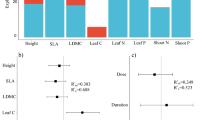Abstract
According to a simple growth model, grazed and ungrazed plants may have equal absolute growth rates provided that the relative growth rate (RGR) of grazed plants increases exponentially with grazing intensity (proportion of biomass removed). This paper reports results from an experiment designed to determine whether plants of two grass species subjected to a gradient of defoliation intensities, from 0 to 100% aboveground biomass removal, showed such a response. The relationship between aboveground RGR and defoliation intensity was exponential and closely matched the theoretical relationship of equal absolute growth rate. Thus, plants showed the same aboveground growth regardless of defoliation intensity thanks to an exponential stimulation of RGR by defoliation. Belowground RGR was depressed by defoliation of more than 20% of the above-ground biomass. In spite of the drastic modification imposed by the treatments on the relative proportions of different plant parts, after a 42-day recovery period basic allometric relationships, such as root:shoot and leafarea: weight ratios, were not affected by defoliation intensity. Exponential aboveground compensatory responses represent a key feedback process resulting in constant aboveground growth regardless of defoliation intensity and appear to be a simple consequence of strong commitments to certain allometric relationships.
Similar content being viewed by others
References
Belsky AJ (1986) Does herbivory benefit plants? A review of the evidence. Am Nat 127:870–892
Brounwer R (1983) Functional equilibrium: sense or nonsense? Neth J Agric Sci 31:335–348
Caldwell MM, Richards JH, Johnson DA, Nowak RS, Dzurec RS (1981) Coping with herbivory: photosynthetic capacity and resource allocation in two semiarid Agropyron bunchgrasses. Oecologia 50:14–24
Cargill SM, Jefferies RL (1984) The effects of grazing by lesser snow geese on the vegetation of sub-arctic salt march. J Appl Ecol 21:669–686
Chapin FS III, McNaughton SJ (1989) Lack of compensatory growth under phosphorus deficiency in grazing-adapted grasses from the Serengeti Plains. Oecologia 79:558–562
Detling JK (1988) Grasslands and savannas. Regulation of energy flow and nutrient cycling by herbivores. In: Pomeroy LR, Alberts JJ (eds) Concepts of ecosystem ecology. A comparative view. Springer-Verlag, New York
Harper JL (1989) The value of a leaf. Oecologia 80:53–58
Hilbert DW, Swift DM, Detling JK, Dyer MI (1981) Relative growth rates and the grazing optimization hypothesis. Oecologia 51:14–18
McNaughton SJ (1979) Grazing as an optimization process: grassungulate relationships in the Serengeti. Am Nat 113:691–703
McNaughton SJ (1986) On plants and herbivores. Am Nat 128:765–770
McNaughton SJ, Chapin FS III (1985) Effects of phosphorus nutrition and defoliation on C4 graminoids from the Serengeti plains. Ecology 66:1617–1629
Oesterheld M, McNauhton SJ (1988) Intraspecific variation in the response of Themeda triandra to defoliation. The effect of time of recovery and growth rates on compensatory growth. Oecologia 77:181–186
Oesterheld M, McNaughton SJ (1991a) Effect of stress and time for recovery on the amount of compensatory growth after grazing. Oecologia 85:305–313
Oesterheld M, McNaughton SJ (1991b) Interactive effect of flooding and grazing on the growth of Serengeti grasses. Oecologia 88:153–156
Richards JH, Caldwell MM (1985) Soluble carbohydrates, concurrent photosynthesis and efficiency in regrowth following defoliation: a field study with Agropyron species. J Appl Ecol 22:907–920
Soriano A (1991) Rio de La Plata grasslands. In: Coupland RT (ed) Ecosystems of the world 8A. Natural grasslands. Introduction and Western hemisphere. Elsevier, New York, pp 367–407
Westoby M (1989) Selective forces exerted by vertebrate herbivores. Trends Ecol Evol 4:115–117
Author information
Authors and Affiliations
Rights and permissions
About this article
Cite this article
Oesterheld, M. Effect of defoliation intensity on aboveground and belowground relative growth rates. Oecologia 92, 313–316 (1992). https://doi.org/10.1007/BF00317456
Received:
Accepted:
Issue Date:
DOI: https://doi.org/10.1007/BF00317456




